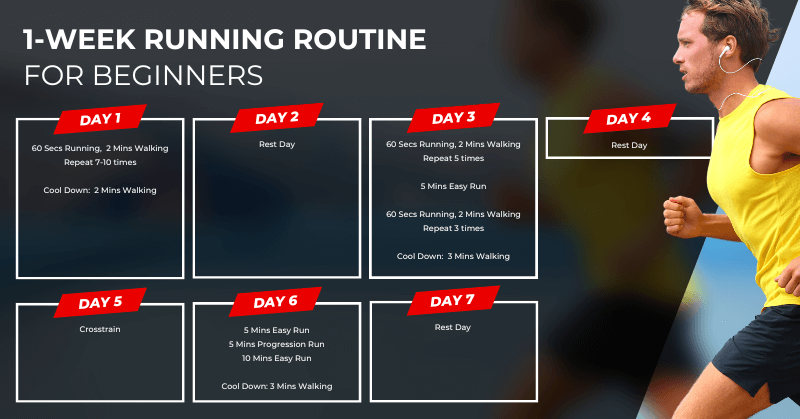6 Types of Runs You Should Know as a Beginner

Running is one of the simplest and most effective ways to keep yourself fit and healthy. It is also very easy to get started and is something that everybody can do. However, it is important to note that running is a high-impact activity and must be undertaken with care.
Like all physical activities, you need to know the fundamentals of running to maintain and improve your technique and form. As a beginner, it’s important that you become familiar with different types of runs. It will help you better understand your strengths and improve yourself as a runner. You can incorporate one or several types of runs in your training to ensure your progress while minimising burnout.
6 Types of Runs for Beginners
1. Recovery Run
Often referred to as the easy-paced run, the recovery run is often recommended after a strenuous running activity like an interval run. A recovery run is not intense and does not require you to push your pace. You will simply allow your legs to get accustomed to running and allow your muscles to recover after a demanding run.
For beginners, the recovery run is what primarily composes your running routine. This allows your body, including your cardiovascular and musculoskeletal system, to adapt to running. Since there is technically no pressure or time constraints when doing a recovery run, you can (and should be able to hold) a conversation going at this pace.
Going for a recovery run at least three to four days a week is recommended for beginners.
2. Base Run

The base run is usually integrated into the early programs of a beginner runner. This is generally called the base period and is only incorporated when you can run for half an hour without having to stop.
Although the base run has relatively low intensity, it is still more demanding compared to a recovery run. A base run aims to improve your aerobic system, running economy and endurance.
A 10-kilometre run done at your natural pace is considered a base run. Ideally, beginners should be doing this run around three times a week. The idea behind a base run is to be able to do it at frequent intervals without the pace feeling challenging.
3. Long Run
A long run doesn’t have a minimum distance. It simply refers to the longest run you can do in a week. If your farthest is 20 kilometres at your natural pace, this is considered your long run for the training week.
Long runs can be your weekly conclusion run and can help you identify how far you can push yourself after a week’s training. This run should feel a bit challenging and should leave you moderately to severely exhausted.
The main goal of a long run is to test and improve your endurance. The distance or duration of a long run can be entirely dependent on you, so you can assess your current endurance level and measure your improvement.
4. Progression Run
Progression runs are similar to base runs, but it involves gradually increasing your intensity and pace as you go through the length of your training.
You can start at your natural pace, and as you run longer, increase your speed until you end with a marathon-like 10k speed. Progression runs are more challenging than base runs but more manageable than interval or threshold runs. It’s considered a medium-effort run that offers less recovery time compared to the usual intense sessions.
Running for 10km at your natural pace, then another kilometre at a faster marathon pace, and finally finishing the last kilometre with half-marathon speed is an example of a progression run. Doing a progression run at least once a week followed by a recovery run is a good training regimen.
5. Fartlek Run
Swedish for “speed play,” fartlek has plenty of similarities with interval training but without a rigid structure and only slightly as intense. It involves a combination of sprinting and jogging and is perfect for beginners as it can also be tweaked to make it a jogging-and-walking combo.
Fartlek is an excellent method for developing your fatigue resistance and efficiency. It builds your endurance and strength while exerting the right amount of pressure and intensity.
As you improve on your running skills and strategies, you can continue using fartlek runs as you will already have that capacity to put on a spurt in your races.
6. Hill Repeats

As the name suggests, a hill repeat run involves repeated sprints going up a hill. The slope choice is up to you and will depend on the hills available in your running area. You can sprint on a steep and short hill that will only take half a minute or opt for a taller hill where you might need a few more minutes before you reach the summit.
The incline, length and the number of times you want to make the sprints will depend again on your running goals. But, this run is suitable for improving your strength, mental endurance and speed.
Since no two hills are the same, sprinting in various locations is also an excellent way to build your confidence and strength.
Sample Weekly Running Routine for Beginners

If you’re a beginner at running, it is ideal to run up to three times a week. And before you start your run, make sure you do your warm-up. Walking for three to five minutes should be enough to get you started on your run. Remember that three to 5 kilometres per run is enough for beginners.
Run 1
You can start with one minute of running followed by two minutes of walking and alternate the two. Do this fartlek-type run for 20 to 30 minutes. Cool down by walking an additional two minutes at the end of your training.
Run 2
Start with a fartlek walk and jog combo for 15 minutes, and follow it up with a recovery run for the next five to 10 minutes. End your routine by going back to a walk and jog combo and finish with walking for another two to three minutes.
Run 3
On the third day, you can start with a recovery run for five to seven minutes, followed by a progression run. Limit your progression run to five minutes, then go back to a recovery pace. End your 20 to 25-minute run by walking for a few minutes.
Conclusion
Running is a very individualised activity, and these different types of runs for beginners can help you better understand what types of runs work best for you.
Don’t forget that if running is not an option for the day, you can still build your endurance and strength by running on the treadmill.
Check our treadmills and our treadmill comparison guide to help and incorporate some diversity into your workout routines.
You May Also Like:
- 7 Healthy Post-Workout Snacks You Can Make in Under 10 Minutes
- Which Powertrain Treadmill Should I Get?
- How to Choose the Best Running Shoes for Beginnerss


